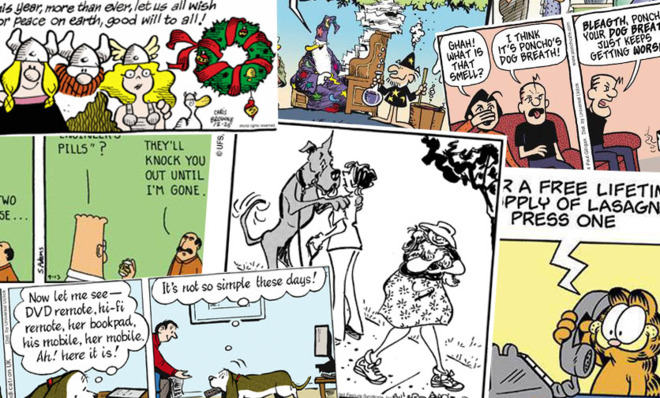Why are newspaper comics so terrible?
The once-proud medium has devolved into inane, artless garbage. This is why it happened — and what can be done to turn it around again.


"As Willie Sutton robbed banks because that’s where the money was, it should never be forgotten that the comics page is where the readers are," said Berkeley Breathed, creator of the beloved newspaper comic Bloom County, in a 2003 interview with Salon.
It's been more than a decade since that interview, and the media landscape has changed considerably, marked by a sharp decline in newspaper subscriptions. But the basic message hasn't changed. In theory, the newspaper comics page still has fascinating potential: a blend of artwork, humor, and editorial that's accessible to children and adults alike. It's the medium that introduced many of America's most beloved pop-cultural icons — from Superman to Charlie Brown to Little Orphan Annie — to a mass audience, and dozens of strips still reach an audience of millions every day.
At a time when both the newspaper industry and the comics industry are looking to expand their market shares, it raises the question: Why are newspaper comics so terrible?
The Week
Escape your echo chamber. Get the facts behind the news, plus analysis from multiple perspectives.

Sign up for The Week's Free Newsletters
From our morning news briefing to a weekly Good News Newsletter, get the best of The Week delivered directly to your inbox.
From our morning news briefing to a weekly Good News Newsletter, get the best of The Week delivered directly to your inbox.
The primary example of the art form's laziness is a comic strip devoted to the idea of being lazy: Garfield, which newspapers and readers alike politely tolerate as it drops a Monday-hating, lasagna-eating fart every day.
In all but the most literal of terms, Garfield hasn't been a comic strip for decades. It's been a front for the multimillion-dollar Garfield brand, which survives only by pushing a supremely uninteresting character into the cultural consciousness. "My working day starts about 6:00 a.m. I read e-mail, answer letters, address business issues," says series creator Jim Davis, explaining an average work day, on the official Garfield website. "I'm involved in lots of meetings and there are always business decisions that have to be made since there are licensing, publishing, TV syndication deals in almost every country."
You might notice that Davis' average workday doesn't actually include any time in which he writes Garfield. "I set aside one week each month to focus on writing the comic strip," Davis goes on to explain. "Once I get in writing mode, the gags can sometimes really flow and I might write four to six weeks worth of material in one week." Davis is open about his very limited involvement in the process of creating a modern Garfield strip; after he writes the strips and pencils a few rough sketches, he hands the reins to a team of assistants. As pretty much any Garfield strip from the past decade or so will show, this is not a creative process that leads to great art.
I don't mean to pick on Davis; he's pretty upfront about Garfield being a business first and a comic strip second. And it's not like the rest of his comics-page cohorts are any better. The Wizard of Id makes bland, terrible jokes about a kingdom. Hagar the Horrible makes bland, terrible jokes about a Viking. Marmaduke makes bland, terrible jokes about a big dog. Fred Basset makes bland, terrible jokes about a British dog.
A free daily email with the biggest news stories of the day – and the best features from TheWeek.com
Even the newspaper comics that made some vague stabs at contemporary resonance, like Dilbert or the now-defunct Cathy, quickly devolved into the same kind of shallow, repetitive gags they originally seemed to rebel against.
When newspaper comics have pushed the limits of the medium, it's been in service of a different but related goal: serialization. For Better or For Worse — the rare newspaper comic to age its characters in real time — drew controversy for a number of polarizing storylines, from the death of family dog Farley to the revelation that a prominent supporting character was gay. In 2007, Funky Winkerbean creator Tom Batiuk drew similar controversy for a lengthy storyline that depicted a major character dying of breast cancer. But these are the exceptions to the rule in a medium that encourages its most successful creators to join a syndicate, start a conglomerate, and churn out a never-ending stream of comics endlessly riffing on the same themes.
Comic enthusiasts tend to wax nostalgic over the medium's glory days, when a cartoonist like Winsor McCay or George Herriman could command a full-color newspaper page for a single comic. But while the conditions that led to canonical masterpieces like Little Nemo or Krazy Kat are long gone, it's not impossible to use the modern limitations of the medium to greater effect. Decades before its slide into corporate mediocrity, Peanuts packed plenty of zen koan-like wisdoms into a four-panel format, which quickly became the industry standard. Calvin & Hobbes creator Bill Watterson openly (and successfully) battled for less restrictive standards for his Sunday comics, but he still managed to tell years of terrific stories in a four-panel format before retiring his strip in 1995, amid frustrations over near-constant attempts to commercialize it.
And that brings us back to Berkeley Breathed, who was heralded as a potential savior when he returned to the comics page with the Bloom County spin-off Opus. Breathed insisted on certain standards for Opus that were alien to the industry: the freedom to tackle uncomfortable political issues, the refusal to publish his strip online, and the insistence on a full half-page from any newspaper that wanted to syndicate it. That was 2003; one by one, those standards gradually eroded, and Opus ended, with relatively little fanfare, in five years.
Despite the failure of Opus, Berkeley Breathed had the right idea all along. "The comic strip works best as deeply personal art and writing produced by near-insane, passionate creators," he said. Even those who chuckle at the occasional Garfield strip would be hard-pressed to say it evinces anything resembling passion, daring, or personality.
Today, the few remaining comic strips with any wit or originality can be found online, free of censorship, deadlines, or panel restrictions. It's hard to blame them for sticking with a format that allows for both more creative freedom and more creative control. But it's frustrating and baffling that newspapers, for all their reach, haven't even attempted to draw on the explosion of talent you can find online.
It's a win-win. With so much potential competition from other cartoonists and entertainment media, truly talented comics creators could use the platform to reach an engaged audience. With so much potential competition from other news sources and entertainment media, newspapers could use their comics pages to distinguish themselves with brilliant voices or artwork.
At a time when audiences are increasingly turning to serialized storylines, there's no limitation to the kinds of stories a creative person could unfold on a daily basis: funny, suspenseful, tragic, or anything in between. It's not too late for a near-insane, passionate creator to make the comics page worth reading again.
Scott Meslow is the entertainment editor for TheWeek.com. He has written about film and television at publications including The Atlantic, POLITICO Magazine, and Vulture.



